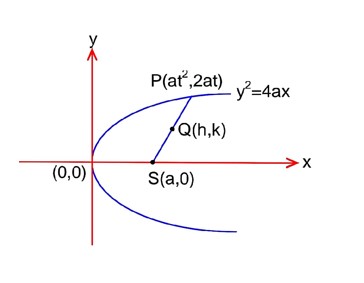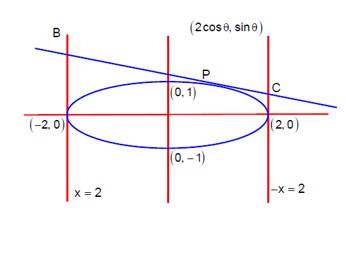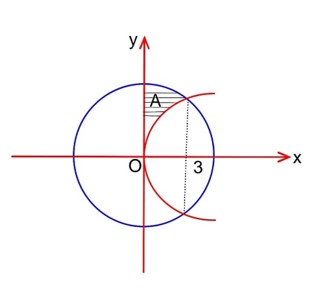Conic Sections
Get insights from 199 questions on Conic Sections, answered by students, alumni, and experts. You may also ask and answer any question you like about Conic Sections
Follow Ask QuestionQuestions
Discussions
Active Users
Followers
New answer posted
2 months agoContributor-Level 9
∫? (√ax - x²/a)dx = a²/6
⇒ (2/3)√a b^ (3/2) - b³/3a = a²/6
also area of ΔOQR = 1/2
(1/2)b² = 1/2 ⇒ b=1
Put in (i) ⇒ 4a√a - 2 = a³ ⇒ a? - 12a³ + 4 = 0
New answer posted
3 months agoContributor-Level 10
C= (2,3), O= (0,0). r = OC = √13.
Slope of OC = 3/2. Slope of PQ = -2/3.
Let P= (x, y). Vector CP = (x-2, y-3). Vector OC = (2,3).
CP.OC=0 ⇒ 2 (x-2)+3 (y-3)=0 ⇒ 2x+3y=13.
Also (x-2)²+ (y-3)²=13.
From 2x=13-3y, x= (13-3y)/2.
(13-3y)/2-2)²+ (y-3)²=13 ⇒ (9-3y)/2)²+ (y-3)²=13
(9 (y-3)²/4) + (y-3)² = 13 ⇒ (13/4) (y-3)²=13 ⇒ (y-3)²=4 ⇒ y-3=±2.
y=5 or y=1.
If y=5, x=-1. P= (-1,5).
If y=1, x=5. Q= (5,1).
New answer posted
3 months agoContributor-Level 10
Reflected point of (2,1) about y-axis is (-2,1).
Reflected ray passes through (-2,1) and (5,3).
Equation: (y-1)/ (x+2) = (3-1)/ (5+2) = 2/7 ⇒ 2x - 7y + 11 = 0.
This is one directrix. Let the other be 2x - 7y + α = 0.
Distance between directrices = 2a/e = |11-α|/√53.
Distance from focus to directrix = a/e - ae = 8/√53.
a/e (1-e²) = 8/√53.
e=1/3. a/e (8/9) = 8/√53 ⇒ a/e = 9/√53.
2a/e = 18/√53 = |11-α|/√53.
|11-α| = 18.
11-α = 18 ⇒ α = -7.
11-α = -18 ⇒ α = 29.
Other directrix: 2x-7y-7=0 or 2x-7y+29=0.
New answer posted
3 months agoContributor-Level 10
S? : x² + y² - x - y - 1/2 = 0, C? : (1/2, 1/2), r? = √ (1/4)+ (1/4)+ (1/2) = 1.
S? : x² + y² - 4y + 7/4 = 0, C? : (0, 2), r? = √ (4 - 7/4) = 3/2.
S? : (x-2)² + (y-1)² ≤ r², C? : (2, 1).
A ∪ B ⊂ C means both circles S? and S? must be inside S?
Distance C? = √ (2-1/2)² + (1-1/2)²) = √ (9/4 + 1/4) = √10/2.
Condition: r ≥ C? + r? ⇒ r ≥ √10/2 + 1.
Distance C? = √ (2-0)² + (1-2)²) = √5.
Condition: r ≥ C? + r? ⇒ r ≥ √5 + 3/2.
√10/2 + 1 ≈ 1.58 + 1 = 2.58.
√5 + 3/2 ≈ 2.23 + 1.5 = 3.73.
So minimum r = (√10+2)/2 and (2√5+3)/2. We need the maximum of these two.
Let's recheck the question logic f
New answer posted
3 months agoContributor-Level 10
Equation of tangent of P (2cosθ, sinθ) is
(cosθ)x + (2sinθ)y = 4
Solving equation of tangent with equation of tangents at major axis ends, i.e. x = -2 and x = 2
For point 'B' (at x=-2):
-2cosθ + 2sinθ y = 4 ⇒ y = (2+cosθ)/sinθ
B (-2, (2+cosθ)/sinθ)
For point 'C' (at x=2):
2cosθ + 2sinθ y = 4 ⇒ y = (2-cosθ)/sinθ
C (2, (2-cosθ)/sinθ)
Now BC is the diameter of circle
Equation of circle: (x+2) (x-2) + (y - (2+cosθ)/sinθ) (y - (2-cosθ)/sinθ) = 0
x²-4 + y² - (4/sinθ)y + (4-cos²θ)/sin²θ = 0
Check if (√3, 0) satisfies this:
(√3)²-4 + 0 - 0 + (4-cos²θ)/sin²θ = -1 + (3+sin²θ)/sin²θ = -1 + 3/sin²θ + 1 = 3/sin²
New answer posted
3 months agoContributor-Level 10
= 2 cos2 θ + 2 sin2 θ + 6 sin q + 45
= 6 sin θ + 47
for maximum of PA2 + PB2, sin θ = 1
then P (1, 2)
Hence P, A & B will lie on a straight line.
New answer posted
3 months agoContributor-Level 10
x2 + y2 = 36 ……(i)
y2 = 9x .(ii)
Solving (i) & (ii)
x2 + 9x – 36 = 0
(x + 12) (x – 3) = 0
x = 3
Let
Required area =
New answer posted
3 months agoContributor-Level 10
k = at ……… (ii)
From (i) & (ii)
Equation of directrix x – a/2 = -a/2-> x = 0

Taking an Exam? Selecting a College?
Get authentic answers from experts, students and alumni that you won't find anywhere else
Sign Up on ShikshaOn Shiksha, get access to
- 65k Colleges
- 1.2k Exams
- 679k Reviews
- 1800k Answers


